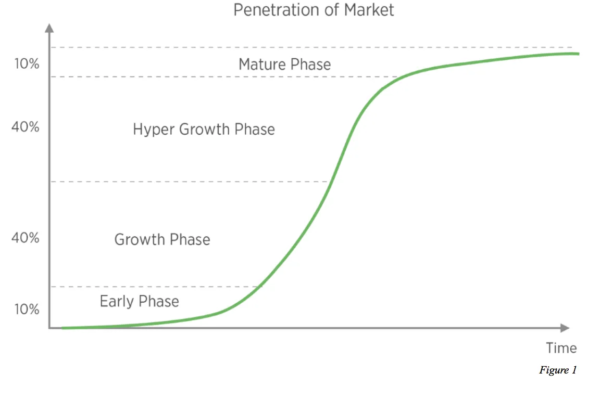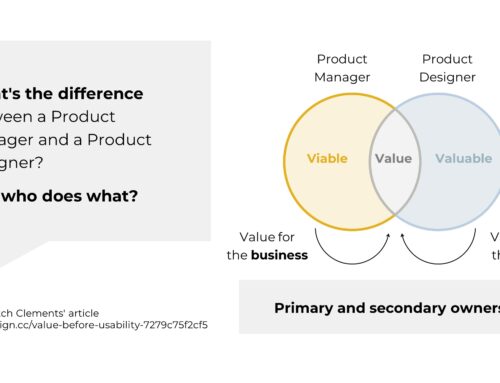Users and product growth
When analyzing product growth, we can identify distinct phases, each characterized by its own pace and dynamics of expansion.
The way to monitor this growth is by tracking the number of new users, the number of users lost (churn), and the number of users recovered (resurrection). The proportion of each of these users will vary at each stage of the cycle.

The S-curve shows the different phases of growth of a product. Source: Evolution of a Product, Sequoia Capital.
In this article, Sequoia Capital (one of the leading venture capital funds) explains the different phases and user dynamics during the evolution of a product. Considering a healthy product:
- In the early stages, there is a greater number of new users and retention is high.
- In growth stages, there is a rapid pace of new customer acquisition, and churn starts to increase, although retention remains high.
- In the maturity stage, the speed of acquiring new users dramatically decreases, while retention and resurrection balance out (customers are lost, but they can also be recaptured).
When the product is already established, the metrics for monitoring the health of a product, in addition to the growth rate (new user acquisition), are retention, stickiness, and engagement.
Ultimately, users are the engine for product growth and business success.
This may seem obvious, but as we’ll see later, it’s an obvious fact that is often overlooked.
Users and product risk
Marty Cagan famously talks about the 4 product risks: value, usability, viability, and feasibility. Although he doesn’t mention it in his article, two very important things can be inferred:
- Two of the four risks (half!) are related to the user.
- These two risks are the most critical, because if you create a product that no one is interested in or can’t be used, then technical feasibility and business viability won’t matter.
Even though value and usability are the most critical risks of a product, they are usually the least validated.
- Value is not validated because functionalities arise from the “great ideas” of the higher-ups, “clients ask for it,” “the competition does it,” or they are “legitimized” by the experience of those in charge because “you’re not going to tell me, after more than 30 years in the industry, what the market wants.”
- Usability is simply not validated due to self-referentiality (also because of lack of knowledge and simple neglect), but mainly because “there is no time.”
What do these models have in common?
They all consider the user as the driver of the product growth and business success.
And yet, when companies make product decisions (which in the end have business consequences), they do so from a project mindset (time, effort, scope) rather than from a product or value perspective.
The priority is simply on delivering (quickly and at all costs, because this is how product and development teams are incentivized and evaluated) instead of on delivering value.
Rarely during roadmap and prioritization, do teams ask:
- How much value does this feature bring to users? (*)
- What impact does this feature have on the business? How does it help grow, improve retention, attract new users, profitability, etc.?
(*) Which is different from asking “how many users does this impact?”. Although teams may ask this question it is equally sterile: if we are not delivering value, what is the point of delivering something worthless to a lot of users? 🙄
The Paradox of Users
User validation, which is the quintessential activity that helps align the product with business objectives (growth, product health, risk reduction), is completely ignored or bypassed because “it takes time,” “it doesn’t fit within the sprint,” or is simply managed through self-referentiality.
This is the paradox of users: while they are the engine of growth and the foundation of a company, they are not prioritized during product development.
Users and product growth
When analyzing product growth, we can identify distinct phases, each characterized by its own pace and dynamics of expansion.
The way to monitor this growth is by tracking the number of new users, the number of users lost (churn), and the number of users recovered (resurrection). The proportion of each of these users will vary at each stage of the cycle.

The S-curve shows the different phases of growth of a product. Source: Evolution of a Product, Sequoia Capital.
In this article, Sequoia Capital (one of the leading venture capital funds) explains the different phases and user dynamics during the evolution of a product. Considering a healthy product:
- In the early stages, there is a greater number of new users and retention is high.
- In growth stages, there is a rapid pace of new customer acquisition, and churn starts to increase, although retention remains high.
- In the maturity stage, the speed of acquiring new users dramatically decreases, while retention and resurrection balance out (customers are lost, but they can also be recaptured).
When the product is already established, the metrics for monitoring the health of a product, in addition to the growth rate (new user acquisition), are retention, stickiness, and engagement.
Ultimately, users are the engine for product growth and business success.
This may seem obvious, but as we’ll see later, it’s an obvious fact that is often overlooked.
Users and product risk
Marty Cagan famously talks about the 4 product risks: value, usability, viability, and feasibility. Although he doesn’t mention it in his article, two very important things can be inferred:
- Two of the four risks (half!) are related to the user.
- These two risks are the most critical, because if you create a product that no one is interested in or can’t be used, then technical feasibility and business viability won’t matter.
Even though value and usability are the most critical risks of a product, they are usually the least validated.
- Value is not validated because functionalities arise from the “great ideas” of the higher-ups, “clients ask for it,” “the competition does it,” or they are “legitimized” by the experience of those in charge because “you’re not going to tell me, after more than 30 years in the industry, what the market wants.”
- Usability is simply not validated due to self-referentiality (also because of lack of knowledge and simple neglect), but mainly because “there is no time.”
What do these models have in common?
They all consider the user as the driver of the product growth and business success.
And yet, when companies make product decisions (which in the end have business consequences), they do so from a project mindset (time, effort, scope) rather than from a product or value perspective.
The priority is simply on delivering (quickly and at all costs, because this is how product and development teams are incentivized and evaluated) instead of on delivering value.
Rarely during roadmap and prioritization, do teams ask:
- How much value does this feature bring to users? (*)
- What impact does this feature have on the business? How does it help grow, improve retention, attract new users, profitability, etc.?
(*) Which is different from asking “how many users does this impact?”. Although teams may ask this question it is equally sterile: if we are not delivering value, what is the point of delivering something worthless to a lot of users? 🙄
The Paradox of Users
User validation, which is the quintessential activity that helps align the product with business objectives (growth, product health, risk reduction), is completely ignored or bypassed because “it takes time,” “it doesn’t fit within the sprint,” or is simply managed through self-referentiality.
This is the paradox of users: while they are the engine of growth and the foundation of a company, they are not prioritized during product development.




